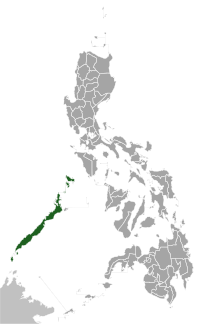Palawan hornbill
| Palawan hornbill | ||||||||||
|---|---|---|---|---|---|---|---|---|---|---|

Palawan hornbills |
||||||||||
| Systematics | ||||||||||
|
||||||||||
| Scientific name | ||||||||||
| Anthracoceros marchei | ||||||||||
| Oustalet , 1885 |
The palawan hornbill ( Anthracoceros marchei ) is a species of bird in the hornbill family that is found in Southeast Asia. Like all hornbills, the palawan hornbill is a cave breeder.
The population of the Palawan Hornbill was classified in the IUCN Red List of Threatened Species in 2016 as " Vulnerable (VU) " = "Endangered".
description
The palawan hornbill reaches a body length of up to 70 centimeters. The beak in the male of the nominate form Anthracoceros albirostris albirostris reaches a length of 14.2 to 17.2 centimeters. In females, the beak remains slightly smaller at 12.6 to 15.7 centimeters. There is hardly any gender dimorphism . The females are slightly smaller and have brown eyes, while those of the males are reddish brown.
The body plumage of the Palawan Hornbill is black except for the tail, on the upper side of the body the plumage has a greenish sheen. The control springs are pure white. A few adults and the majority of juveniles have black spots or black feather shafts on the tail feathers. In some individuals, the wing feathers also have white tips. The bill is creamy white to pale yellow, the lower bill is black at the base of the beak. The beak horn begins above the forehead and ends in adult birds tapering to a point above the front half of the beak. The featherless skin around the eyes and the bare throat patch are bluish white. The orbital ring around the eye is black.
The body plumage of the young birds is similar to that of the adults. The beak, which is still cream-colored, is much smaller; the beak horn has not yet developed. The bare skin around the eye is bluish white, like that of the adult birds, the black orbital ring is still missing, the eyes are gray.
Distribution area
The palawan hornbill is limited in its distribution to the Philippine island of Palawan and the smaller island immediately adjacent to its coast. Palawan is stretched out between the South China Sea in the northwest and the Sulu Sea in the southeast. The main island is about 450 km long, on average about 40 km wide and crossed by a mountain range, the highest point of which is Mount Mantalinganhan at 2085 m . There is an always humid tropical climate. Due to northeast trade winds and southwest monsoon winds , the least rainfall falls from November to April, most between June and October. The annual averages for Puerto Princesa are 27.4 ° C, 1607 mm of precipitation and 68.9% relative humidity . The island is known for its high level of biodiversity and endemism . The endemics besides the palawan hornbill include the palawan rat , the palawan pangolin or the palawan peacock pheasant , and 1522 species of flowering plants.
The palawan hornbill colonizes both primary on the island. as well as secondary forest. It is also found in mangrove swamps and near agricultural areas. It is particularly common at the edges of forests. Because of its reproductive habits, forests with old tree populations are essential. The population of this hornbill is therefore particularly threatened by deforestation.
Way of life
The palawan hornbill lives solitary or in small groups. It looks for its food both in the treetops and on the ground. Foraging troops can be heard from afar because of their calls and the sound of their wings beating.
The palawan hornbill mainly eats fruit, as well as animal protein in the form of insects and lizards.
literature
- W. Grummt , H. Strehlow (Ed.): Zoo animal keeping birds. Verlag Harri Deutsch, Frankfurt am Main 2009, ISBN 978-3-8171-1636-2 .
- Alan Kemp: The Hornbills - Bucerotiformes . Oxford University Press, Oxford 1995, ISBN 0-19-857729-X .
Web links
- Anthracoceros marchei in the endangered Red List species the IUCN 2012. Posted by: BirdLife International, 2012. Accessed October 26, 2016th
- Calls of the Palawan Hornbird on Xeno-Canto
Single receipts
- ↑ a b Anthracoceros marchei in the endangered Red List species the IUCN 2016 Posted by: BirdLife International, 2016. Retrieved on 3 October 2017th
- ↑ a b Kemp: The Hornbills - Bucerotiformes . P. 171.
- ↑ a b Kemp: The Hornbills - Bucerotiformes . P. 170.
- ↑ climatemps.com . Retrieved October 29, 2016.
- ↑ Kemp: The Hornbills - Bucerotiformes . P. 172.
